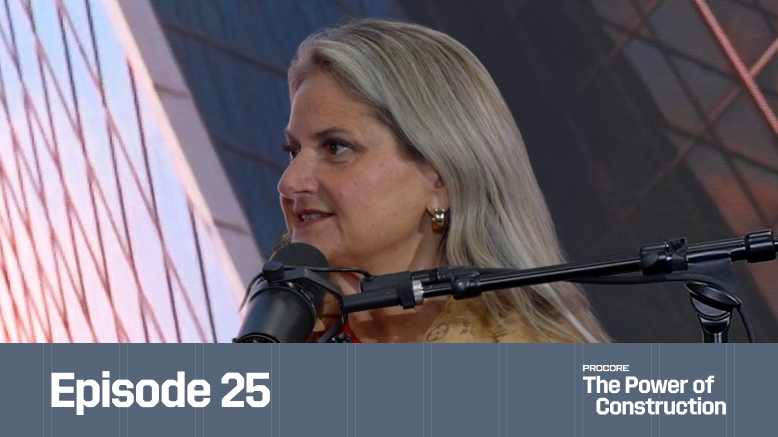— 7 min read
How GCs Can Use Tech to Bridge Field-to-Office Communication Gaps


Last Updated Sep 23, 2025

Blake Johnson
Manager, Strategic Product Consultants, General Contractors
Blake Johnson is a Manager of Strategic Product Consultants at Procore, with a focus on General Contractors. Previously, he worked in Austin, Texas as a Project Manager for Fazzone Construction Company and Slater Painting Company, and as Assistant Project Manager for Journeyman Construction. He has experience in scheduling, estimating, job costing, supplier negotiation, and supervision of project teams. He lives in Vancouver.

Kacie Goff
Contributing Writer
91 articles
Kacie Goff is a construction writer who grew up in a construction family — her dad owned a concrete company. Over the last decade, she’s blended that experience with her writing expertise to create content for the Construction Progress Coalition, Newsweek, CNET, and others. She founded and runs her own agency, Jot Content, from her home in Ventura, California.
Last Updated Sep 23, 2025

In some ways, general contractors (GCs) are in a golden age of construction communication. An ever-growing suite of tools should help them better connect the office and the field faster and more easily.
In reality, though, many GC firms still struggle here. Some haven’t adopted technology to streamline communication. Others have — but haven’t seen the expected results. Sometimes, for example, a response to a request for information (RFI) might come in minutes thanks to the technology in play. But in other cases, it might take weeks, maybe because of duplicate communication or a missed ping by a stakeholder.
A lot of GCs are understandably frustrated here — as are their affected team members.
Table of contents
Common Field-to-Office Challenges — and the (Literal) Cost for GCs
Part of the struggle to communicate comes from the sheer volume of information that needs to be disseminated. There are so many moving parts on any construction project that this gets difficult. Trickier still is not just transmitting the information, but getting it to the right person. Sometimes, the person communicating might not know the full scope of the issue, or who to talk to about it.
Highlighting a few specific areas illuminates just how widespread office-field communication gaps currently are for a lot of GCs.
u003cstrongu003eDrawing Revisionsu003c/strongu003e
Whether it’s tied to an RFI, submittal, or something else, revised drawings need to be widely distributed. If the project relies on hard-copy plans, that means updating the drawings in the office, in the jobsite trailer and even the copies kept in peoples’ work trucks. Even if there are digital copies of the drawings, communicating changes can get tricky, especially if people operate from copies they’ve saved locally. Building off the wrong set of drawings usually means costly rework.
u003cstrongu003eRFI Responsesu003c/strongu003e
The faster an RFI can get answered, the faster a project can move forward. Communication issues plague GCs here, ranging from incomplete information in the RFI to sending it to the wrong stakeholder. This introduces delays, increasing the GC’s risk of schedule overruns and liquidated damages.
u003cstrongu003eChange Ordersu003c/strongu003e
If a change order alters the contract’s scope, communication is paramount. Without strong communication around the change order, for example, a subcontractor might resist the required work, arguing that it falls outside the agreed-to scope. Bringing any affected subs along in change order communication helps them understand the change’s necessity and, just as importantly, plan for the additional work.
Punch Lists
Punch lists are a valuable tool that help GCs wrap up projects thoroughly. If everyone’s operating off their own copy of the punch list, though, it’s hard to know what’s been done and what still requires attention.
At best, managing these communication challenges creates more work for the GC’s team. At worst, they introduce delays, rework and cost overruns. Plus, bad communication increases the likelihood of disputes, further slowing projects and introducing more risk for added cost for the GC.
Since most GCs operate on razor-thin margins, the potential expense of poor field-office communication is well worth avoiding.
Free AI in Construction Course with Hugh Seaton
Start learning today with industry expert Hugh Seaton and discover how AI can boost efficiency, reduce risk, and transform your projects.

The Key to Successful Field-Office Communication: Centralized, Non-Duplicated Information
Any tool that centralizes communication can help GCs streamline their processes and avoid headaches.
This central hub allows team members to collaborate on documents so they can access and share information in real-time. It also gives GCs a way to make sure everyone’s tapping into the right information (e.g., the latest version of the drawings, the most updated version of the punch list).
Once that central information source is established, the GC should regularly encourage team members to access information through it, not their local storage (i.e., the version they have saved to their computer, phone, or tablet).
In this central location, it’s also important for team members to apply the document management best practice of version control. Duplicates introduce a number of potential issues. Versioning communications — particularly around core documents like drawings and change orders — points everyone toward the most up-to-date information.
The format doesn’t necessarily need to be sophisticated here. It certainly doesn’t need to be expensive or complicated. Even a spreadsheet or word document could work. The key is making sure it’s:
- Centrally stored
- Accessible to all applicable stakeholders
- Showing updates in real time
Literally any tool that centralizes project communication [will be helpful]. It doesn’t even have to be all project information; it could be communication central to a certain topic, idea, or scope. If you can put in place a repository for information that’s available to all project stakeholders, you're going to find positive results.

Blake Johnson
Manager, Strategic Product Consultants, General Contractors
Procore
Once the centralized communication hub is established, the next step is to make sure it’s equally accessible from both the field and the office.
That might mean equipping the field team with tablets or putting in a wireless network setup for jobsites that don’t have cellular connectivity. This extra work on the frontend requires investment. But because it reduces communication challenges and the many added costs they can introduce, it helps GCs protect their profit margin on that project.
Best Practices for Centralized Comms at a GC
Each GC’s needs around a centralized communication hub differ. Still, there are some best practices that apply across the board.
Keep it simple (when possible).
Adding complexity can subvert the GC’s goal of streamlined communication. A complicated process for uploading, accessing, or updating documents might lead team members to fall back on their old communication channels. The simplest solution is often best.
Here, the team can point the GC in the right direction. Asking people how they’re currently communicating and identifying what’s already working should help to illuminate the path forward.
Think about simplifying the way that you convey information, and that will automatically streamline the process.
Blake Johnson
Manager, Strategic Product Consultants, General Contractors
Procore
Keep it consistent.
For a centralized communication hub to function as intended, the GC needs to establish standard operating procedures (SOPs) for it. Specifically, set up a consistent way of capturing and distributing the team’s most important communications.
Sit down with stakeholders to create those SOPs. These SOPs should be created by the people who perform the tasks and understand their implications. Tap the jobsite superintendent, safety supervisors and other people integrally involved to provide their insights when developing those procedures.
Then, distribute them to every team member. It might be beneficial to tailor the SOP to different roles. The GC might want to have one SOP for accessing the hub from the office and another for the field, for example.
Define the workflow and make sure that everybody understands that. If you standardize that communication between all the project stakeholders, that alone is going to help you reduce communication issues.
Blake Johnson
Manager, Strategic Product Consultants, General Contractors
Procore
Keep it updated.
Projects change. Clients change. Technologies change. As a result, the way a GC uses its centralized communication hub will likely need to evolve, too.
The way to really refine your systems and processes is to listen to the folks who use those systems and processes every single day.
Blake Johnson
Manager, Strategic Product Consultants, General Contractors
Procore
To proactively manage those changes, GCs can establish an operational excellence committee. Task this team with collecting insights from team members in the office and the field. Maintaining an open forum where people can share pain points and suggestions helps the GC adapt its central hub as needed.
Keep it embedded.
The leaders at the GC need to do what their title suggests: lead. Both culture and ways of working tend to flow down from the top. Leadership needs to model using the central hub and the SOPs that surround it.
Pro Tip
Culture flows downhill: If your C-suite doesn't communicate well with your rank-and-file employees, that's going to set a standard.
Looking Forward to Communication Wins
Walk into any construction expo or conference and a sea of communication technology vendors await. The space is flooded because tech is consistently useful for improving communication (as any construction pro who had to mail or fax documents before email knows well).
Still, technology is a tool just like anything else. The GCs who see wins here will be the ones who learn how to wield those tools to their team’s advantage.
Embracing the opportunities here and being willing to explore them helps firms find the right specific software and solutions for their unique needs. The right hub for a company that primarily uses paper drawings is probably very different from the best fit for a team that’s heavy into BIM, for example.
As firms evaluate the wide range of available communication technology options, they should keep one focus at the forefront: centralizing key information and communication about that information in the simplest way possible.
Was this article helpful?
Thank you for your submission.
0%
0%
You voted that this article was . Was this a mistake? If so, change your vote
Scroll less, learn more about construction.
Subscribe to The Blueprint, Procore’s construction newsletter, to get content from industry experts delivered straight to your inbox.
By clicking this button, you agree to our Privacy Notice and Terms of Service.
Thank you!
You’re signed up to receive The Blueprint newsletter from Procore. You can unsubscribe at any time.
Categories:
Written by

Blake Johnson
Manager, Strategic Product Consultants, General Contractors | Procore
Blake Johnson is a Manager of Strategic Product Consultants at Procore, with a focus on General Contractors. Previously, he worked in Austin, Texas as a Project Manager for Fazzone Construction Company and Slater Painting Company, and as Assistant Project Manager for Journeyman Construction. He has experience in scheduling, estimating, job costing, supplier negotiation, and supervision of project teams. He lives in Vancouver.
View profile
Kacie Goff
Contributing Writer | Procore Technologies
91 articles
Kacie Goff is a construction writer who grew up in a construction family — her dad owned a concrete company. Over the last decade, she’s blended that experience with her writing expertise to create content for the Construction Progress Coalition, Newsweek, CNET, and others. She founded and runs her own agency, Jot Content, from her home in Ventura, California.
View profileExplore more helpful resources

Profit from Predictability: Construction Software as a Business Strategy
For general contractors, managing complex, multi-million-dollar projects, every project phase — from planning and budgeting to on-site execution — is an opportunity to lose time and money. Construction software is...

Defending Against Financial & Legal Risks on Megaprojects
The construction industry has seen marked growth in megaprojects. Some experts classify any project over $500 million as a megaproject, while others argue that the build needs to be $1...

Unlocking Project Intelligence: Moving from Raw Data to Actionable Insights
The construction industry faces a wide range of challenges, from ongoing labor shortages to frequent cost overruns. But some the biggest hurdles all stem from unpredictability. The general contractors (GCs)...

Who is accountable for innovation in construction?
Everyone says construction needs to innovate—but no one agrees on who’s actually responsible for making it happen. Is it the owner? The builders? The tech vendor? Or is innovation everyone’s...
Free Tools
Calculators
Use our calculators to estimate the cost of construction materials for your next project.
Templates
Find a template to help you with your construction project tasks.
Material Price Tracker
Get the latest U.S. retail prices and view historical trends for common building materials.
Glossary
Explore key terms and phrases used in the industry.
